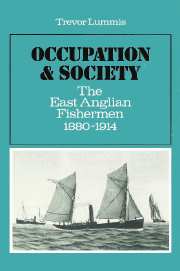Book contents
- Frontmatter
- Contents
- List of figures and tables
- Acknowledgements
- Map
- Introduction
- PART ONE OCCUPATIONAL STRUCTURE
- PART TWO THE SOCIAL STRUCTURE
- 5 The concept of community
- 6 The social structure of ownership
- 7 Images of social structure
- 8 Political attitudes
- PART THREE THE FAMILY, SOCIAL PRACTICE AND BELIEF
- Appendix: supplementary information on the interviews
- Glossary
- Notes
- Bibliography and sources
- Index
5 - The concept of community
Published online by Cambridge University Press: 22 October 2009
- Frontmatter
- Contents
- List of figures and tables
- Acknowledgements
- Map
- Introduction
- PART ONE OCCUPATIONAL STRUCTURE
- PART TWO THE SOCIAL STRUCTURE
- 5 The concept of community
- 6 The social structure of ownership
- 7 Images of social structure
- 8 Political attitudes
- PART THREE THE FAMILY, SOCIAL PRACTICE AND BELIEF
- Appendix: supplementary information on the interviews
- Glossary
- Notes
- Bibliography and sources
- Index
Summary
In no section of our population is heredity of occupation so rigidly preserved as amongst our fishermen; they are a class apart, intermarrying, having their own peculiar customs, modes of life and thought, and mixing but little with people outside their own little communities.
Duke of Edinburgh 1883The above quotation emphasises both the occupational and residential aspects contained in the concept of community: it is rather ironical that it comes from an article which establishes that the high death rate amongst East Coast fishermen at that time was due to the system of fleeting which at Grimsby employed hundreds of apprentices and ex-apprentices drawn from workhouses all over England and whose lives had no connection with the occupational or residential world of their parents. That was, perhaps, something of an exceptional phenomena, and fishing areas have usually recruited local labour or migrant fishermen and might in general be considered traditional communities.
The essence of ‘community’ is that it is a self-enclosed occupational and social world, but more than that it was a single-stratum world, and earlier commentators (Jenkins, cited in chapter 1, expressed concern that the ‘community’ would be split into ‘employers’ and ‘employees’) saw the widespread ownership of capital as the keystone of this community. This view was supported in a more recent essay which argued that ‘community’ existed in the traditional inshore and drifter industries but that trawling created a new class of fishermen ‘so different from those of the boatowning or sharing, village-dwelling hereditary fishermen’.
- Type
- Chapter
- Information
- Occupation and SocietyThe East Anglian Fishermen 1880-1914, pp. 73 - 77Publisher: Cambridge University PressPrint publication year: 1985



